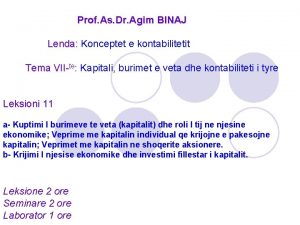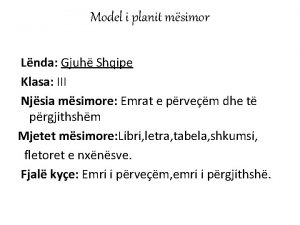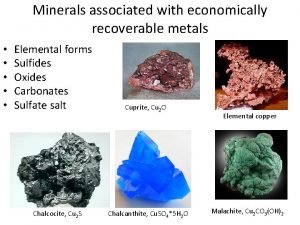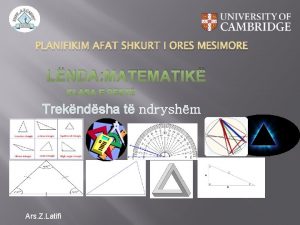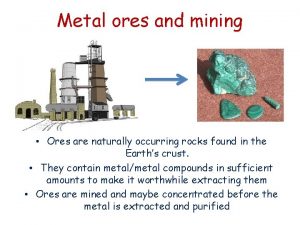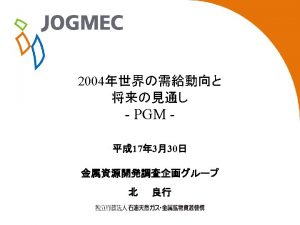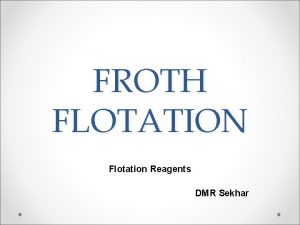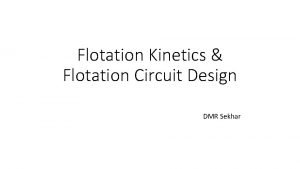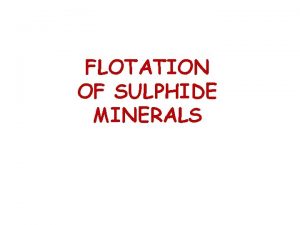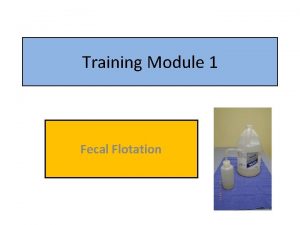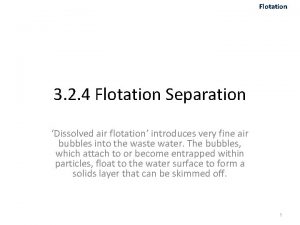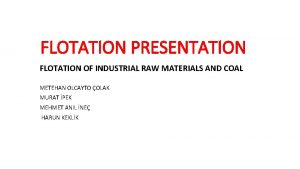FLOTATION OF PLATINUM GROUP METAL PGM ORES PGM












- Slides: 12

FLOTATION OF PLATINUM GROUP METAL (PGM) ORES

PGM Minerals � There are over 100 PGM minerals � These minerals are subjected to a wide range of elemenlat substitution PGM İdeal Formula Other Elements Present Braggite (Pt. Pd)S (Pt. Ni. Pd)S Cooperite Pt. S (Pt. Ni. Pd)S Kotulskite Pt. Te (Pd. Pt)(Te. Bi. Sb) � There is a large variation between stochiometric formula and compositions of the given mineral from various locations. � It is common to find these minerals with sulphide deposits

PGM Deposits � PGM concentration should be between 100 -1000 ppm � PGM are associated with Cu, Ni and precious metals � Almost all of PGM deposits contain Ni minerals � PGM deposits are classified as; � PGM-dominated deposits � Ni-Cu dominated deposits � PGM-Dominated � Merensky type � Hydrothermal � Placer Deposits

PGM Deposits � Merensky type � Basaltic magma (pyroxene and peridotite zones) � The main sulphides are pyrrhotite, chalcopyrite, pentlandite and pyrite � Rich in floatable silicates (talc) and chromite � Busheld Complex (South Africa), Great Dyke Zone (Zimbabwe), Stillwater Complex (Montana, USA) � Hydrothermal � Pyroxene Deposits and peridotite zones affected by supergene alteration. � The main sulphides in the ore include pyrite, chalcopyrite, pyrrhotite, covellite and marcasite with associations of electrum, pentlandite and PGM. � New Rambler Deposit (Wyoming, USA)

PGM Deposits � Placer Deposits � Processed in the Soviet Union, Canada, Columbia and the United States. � Alaskan-type ultramafic rocks enriched in PGM, in particular in the vicinity of concentration of chromite and with alpine ultramafic bodies. � As a process of weathering there is a marked change in Pt/(Pt–Pd) ratio � Examples of this include the placer related to the Norilsk sulphide deposits and deposits found in Ural region USSR.

Effect of Mineralogy on Selection of Concentration Process � Ores amenable to � gravity preconcentration � Flotation � Hydrometallurgy � Ores Amenable to Gravity Preconcentration � PGM occur as minerals of high density, � High degree of liberation (no middling) � the grain-size distribution suitable for gravity techniques � Placer deposits are suitable for this process � The principal PGM minerals include Pt-Fe alloys (Pt 2 Fe, (Ir, Pt))

Ores Amenable to Flotation � PGM Sulphide Dominated Deposits � PGM are in general associated with base metal sulphides, as grain boundaries between sulphides and silicates, or solid solution. � PGM are recovered in a bulk Cu/Ni/Co/PGM concentrate � In many cases these ore types contain floatable nonopaque gangue minerals, including talc, chlorites, etc. � PGE � Low Dominated Deposits sulphide content and PGM concentration in a range between 5 and 30 g/t. � Merensky Reef of the Bushveld Complex in South Africa. � Stillwater Complex in Montana, USA.

Flotation of PGM Ores � � � � � PGM carriers (i. e. pyrrhotite, pyrite, pentlandite, etc. ) have different flotation properties under some flotation conditions. The selectivity between sulphide minerals and gangue minerals is important In the majority of cases, a hydrophobic gangue depressant has to be used. Pyrrhotite is a relatively slow floating mineral, especially monoclinic pyrrhotite, which is usually present in these ore types. The floatability of pyrrhotite also decreases when using certain hydrophobic mineral depressants, such as guars and dextrins. The flotation of pyrrhotite may improve with small additions of copper sulphate (Cu. SO 4). Chalcopyrite and pentlandite float well using a xanthate collector and in certain operations, the recovery can reach greater than 90%. Violarite is the least floatable mineral of all the sulphides and represents a major loss of PGM in the flotation tailing from a number of operations. Reagents: � � � p. H (Natural)=9 -10 Collectors: SIBX+Dithiophosphate or Mercaptan Frothter: DOW 250 or similar Depressant: Guar gum or CMC Activator: Cu SO 4

Flotation of Sulphide Dominated Ore

High- Chromium PGM Containing Ores

Reagent Scheme and Metallurgical Results � Amplats (Merensky Reef, South Africa) � Sulphide-dominated PGM ore composed of Cu, Ni, pyrrhotite and some pyrite. � This ore contains a fair amount of floatable gangue minerals � Grind: P 80 of about 105 µm � Reagents: � Cu. SO 4 = 200– 300 g/t, � CMC = 200– 400 g/t, � Amyl xanthate = 100– 250 g/t, dithiophosphate = 40– 80 g/t � Metallurgy: � Total PGM concentrate grade = 70– 85 g/t, � PGM recovery = 82– 85%

Reagent Scheme and Metallurgical Results � Barrier Reef Plant (South Africa) � High-chromium PGM ore. � Main gangue minerals are chromite with some silicates, calcite and clay-like slimes � Grind: P 80 = 150 μm for stage 1; P 80=90μm for stage 2 � Regrind: Cleaner tailings � Reagents: � Xanthate mixture = 250– 300 g/t; mercaptan = 30– 50 g/t; � modified guar = 50– 100 g/t; � Cu. SO 4=50– 100 g/t � Metallurgy: � Total PGM in concentrate = 80– 110 g/t at 2. 75% Cr 2 O 3, � PGM recovery = 83%50

